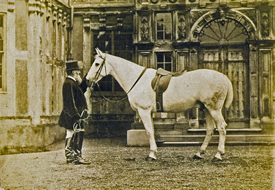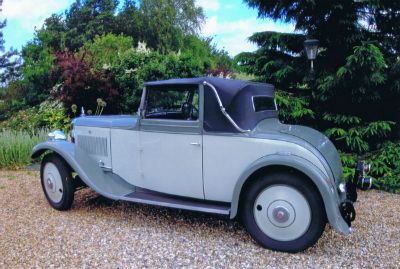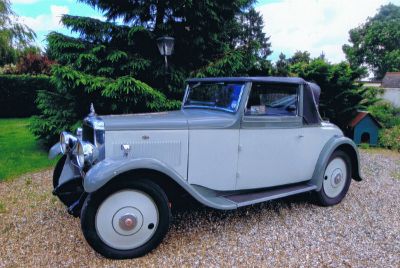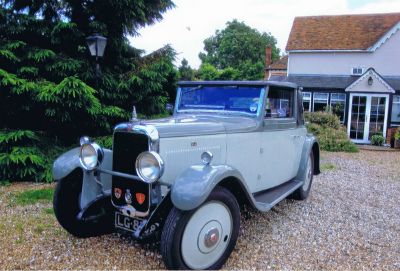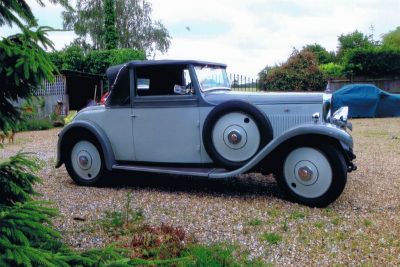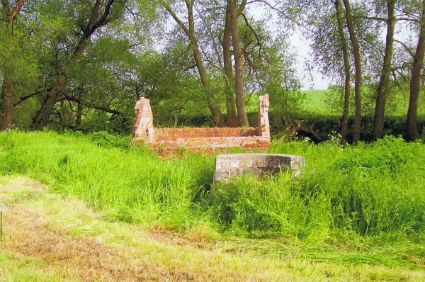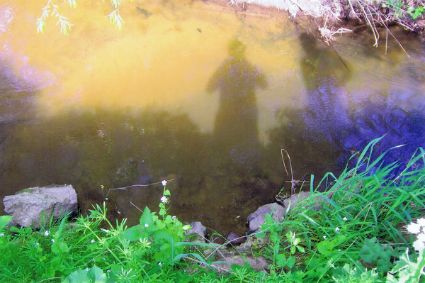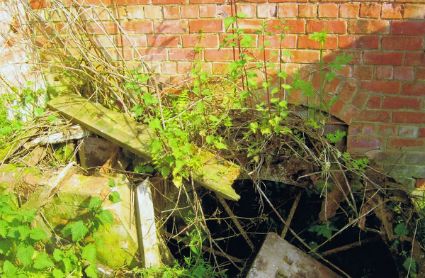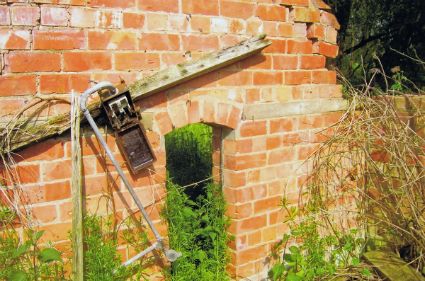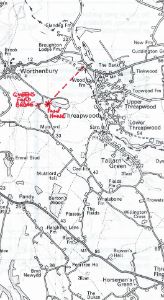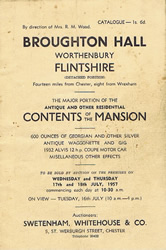Broughton Hall
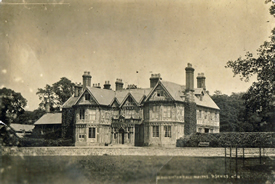
Broughton Hall was built in Threapwood for Randall Broughton in about 1642 when it replaced an earlier house. It is rectangular with two of its sides terminating in four gables with added bays in the front elevation at ground and first floor levels. The oldest part constructed of oaken beams, the interstices filled in with brick work covered with plaster. The beams were never painted, nor the plaster whitewashed however the timbers were oiled every 100 years. The tops of the two stories were ornamented externally with lines of carved corbels. The porch although in strict character with the older portion was not added till 1852. A red brick addition was added to the half timber house at the beginning of the 19th century.
The ornamental brick chimney stacks towered above the complex slate roof.
The front projecting porch was built in stone and the family coat of arms was set above the heavy- studded front door. This item and the two bows to the front elevation were added at a later date, sometime in the 1850s, by Robert Howard.
The earlier house had two small gabled bays each side of the front entrance, and later, probably when the two bays were added, the front entrance with first floor were brought forward to level the centre front elevation.
The added front porch was so completely in keeping with the rest of the house that it could well have been mistaken for part of the original building. At the time of the demolition of the house, the front elevation presented a picture of two large gables at north and south, with three considerably smaller gables in between. Also it had been much added to over a long period at the north, east and south sides.
The cellars could only be described as a 'rabbit-warren', and it is known that it was possible to move from cellar to attic floor by a most ingenious passage constructed around the massive central chimney stack, obviously an 'escape route'.
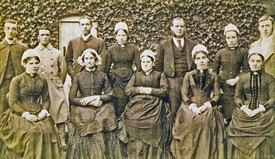 Broughton Hall staff circa 1900.
Broughton Hall staff circa 1900.
The house contained a number of secret staircases and hiding places for priests - relics of the more troubled religious times and the troubled political period of Charles I, the monarch who ruled despotically and made great efforts to restore Catholicism in the country.
Before the bays were added, the front elevation had five windows at ground level and seven at first floor level with a window in each gable at attic floor, with a central dormer window in the roof immediately in front of the bell-house. The north wing at this date having only one window at ground level are opposed to two in the south wing. When the almost rounded bays were added to the front elevation three windows were built in each, with two windows (similar) at each side of the entrance door, this pattern repeated at the first floor with a window over the entrance door, thus there were eight windows at ground floor, and nine at the first floor with a window in each gable retained and the dormer window had disappeared giving place to a window in the gable immediately over the front entrance door.
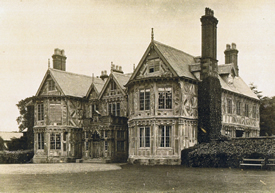 Front door with window in gable over the front door.
Front door with window in gable over the front door.
A plan of Broughton Hall showed the main block containing a Library, two Drawing rooms, a long dining room, a Justice's room, and a pantry, with a large square entrance hall. The domestic block at the north of the main block consists of two Housekeeper's rooms, Servants' dressing room, Kitchen, hack kitchen, larder, scullery, plate room or Butlers' pantry, store closet with cellar entrance. Across a large yard were several outbuildings consisting of wash-house and Laundry, Brew house, Bake house and Milk house. The woodwork of the interior of the main house was almost entirely of oak, a few doors were oak and were ornamented with carving but most doors were of oak two sunken panels in very heavy frames, The Library fitted from floor to ceiling with open oak book shelves, had one pair of oak pillars about nine feet high supporting the central beam of the room. The main entrance doors of the Hall were a pair of ornately carved oak double doors. The entrance hall contained a carved oak fireplace inscribed "when Friends meet, Hearts warm', this faced the entrance doors, The Drawing rooms were completely paneled in pine the frieze carved in a garland pattern, Part of the Dining room was also paneled in pine, Some of the original fireplaces were filled in with marble Victorian mantelpieces. Some had dog-grates, and some the basket type of grate.
At the top of the main staircase was an imposing metal diamond shaped glazed window containing painted family crests. The finest feature of this old house was the main staircase, a massive Elizabethan oak stair with early barley sugar twist rails, a moulded hand rail and carved newels, four in all, one at each turn in the staircase, these newels were surmounted by very early carved grotesque animal figures. There were twenty very wide treads to this stair. A Jacobean oak staircase led from the ground floor to the modern Billiard room and to the attic floor. The extensive gardens were surrounded by a Ha-Ha, The boundary between Wales and England and between the counties of Cheshire and Flintshire runs through the grounds of Broughton Hall marked now by large modern boundary stones.
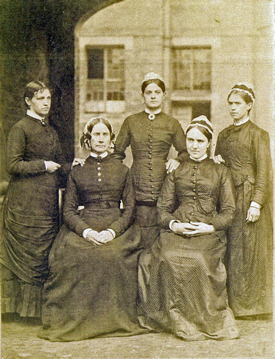 Most of the staff of Broughton Hall were female.
Most of the staff of Broughton Hall were female.
The first family to live at Broughton Hall were the Broughton's. One of the leading Royalists supporting Charles I during the English Civil War was Sir Edward Broughton. Among the Parliamentarian forces were some soldiers at Nantwich who were local men and knew the district well. On October 23rd 1643 they marched from Nantwich and captured Broughton Hall, and took it by surprise, capturing Sir Edward and two of his sons. No details survive as to the fate of Sir Edward and his family. The Broughton family was succeeded by the Whitehall's, and by the Davies's and later by the Howards, and finally before the demolition by the Willis's.
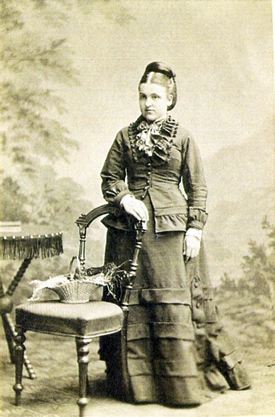 Miss Elizabeth Howard Circa 1880
Miss Elizabeth Howard Circa 1880
Memories of Bill Freeman a Broughton Hall Employee
I lived in the bottom lodge on the Boughton Estate from 1929 to 1945. We were very happy there although we were not well off by any means. I remember Kitty Howard (Elizabeth) mainly for her meanness to my Father who was employed as gamekeeper on the Estate. She would drive down to the gate outside our lodge, sound her horn until one of us would open the gate for her. If it was me or my brother that went out, she would throw us a penny for our trouble. She was a good horse rider and rode with the Hunt which was held 2 - 3 times during the winter months. I can remember my father who had to go out the night before the Hunt and stop all the holes to prevent foxes taking refuge next day. Mother would get very worried as he got home in the early hours of the morning. From the age of four I attended the Threapwood School until I passed my 11+ to go to Wrexham Grammar School. I was quite proud of myself but only for a very short time as I hated Wrexham and the lessons there.
Bill Freeman has provided this photo of him and his elder brother Michael outside of their lodge at Broughton Hall. Bill looks about 6 in this photo - Michael was 4 1/2 years older |
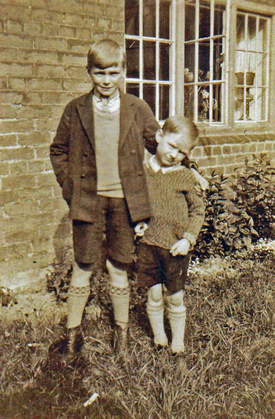 |
|---|
Once every two years a traction engine complete with saw bench would arrive in the yard at Boughton and would spend about a week sawing timber from the Estate. They made gateposts, fencing posts and rails, and timber for all of the Estates requirements. My brother and I would go straight to the yard on the way home from school to help. My father used to spend all day in the winter months rabbiting. I remember he went out very early in the morning arriving home in the evening. I always remember him bringing the ferrets into the kitchen to have their muzzles put on by my mother which was a fiddly job, then my father would put them back in their box and put them over his shoulder along with the nets and of course his lunch before setting off for the day. On his other shoulder he would carry a spade, in case he had to dig out the rabbit and ferrets. On arriving home he often brought up to a dozen rabbits hanging from the spade. As I got a bit older I would go with him and I would have to carry the ferrets. I remember I was very happy being allowed out with my Father and Ben the dog.
At the start of the war the house was full of servants but as time went by they gradually diminished. The Howards had their own maid, butler, and cook all living at the Hall. The Chauffeur lived in the middle lodge, the head gardener in the top lodge, and we lived in the bottom lodge. John Howard - Kitty's brother was wheelchair bound in his later years and we often saw him in the grounds. When we came home from school we would touch our caps as a mark of respect. As the war continued and the servants disappeared from the hall, my mother became cook. She would cycle up the drive at 4 p.m. to get dinner. When I think about it now I don't know how she managed as she only had a simple single range to cook on. My Mother came home one evening and said Kitty had told her that she was the best cook that she ever had. I was not surprised as I knew that she had been trained in London as a professional cook. We obviously benefited during the war when things were in very short supply.
I also remember that they used to have a truckload of coal delivered to Bangor station. I used to go with the wagoner and his horses to go and collect the coal which used to take up to four separate journeys back to Boughton.
Every two or three years two men would lodge with us for a couple of weeks. They would fell timber on the estate. Timber was very valuable to the Howards and produced significant income. Once felled, horses were brought in to move the timber from the woods and then load large wagons for the sawmill by means of three shearlegs roped together to form a horse powered winch. I was always most interested in the horses and would spend happy days watching them work. This brings me back to Kitty Howard and I still remember her meanness to my father. She would only give him just enough biscuits for Ben the dog to last the week, and only issue him with a few shotgun cartridges at a time and expect him to supply the same number of game for her larder.
Bill Freeman
Following this letter from Bill Freeman appearing on the web site another member of the Freeman family has been in touch to add a few more memories and provide an interesting photo of a small relic from Broughton Hall.
Hello
I have been enjoying looking at your website and particularly the story from Bill Freeman, who is my uncle. My dad, Michael Freeman, was his elder brother seen in the photo. My dad loved Threapwood and always thought of it as home, even though he moved away when he was 15 to go to a job in Cornwall. My dad died 2009 and his ashes are scattered in the field opposite Broughton Lodge, as was his final wish. I don't know if it is of any interest but I am attaching a photo of a finial that came from Broughton Hall. My dad used to have this on his desk and I now have it. I believe his school friend. Jack Stringer, who is still alive and living in Gloucestershire, gave it to him - I think he may have salvaged it when the Hall was demolished.
All good wishes
Gill Knappett
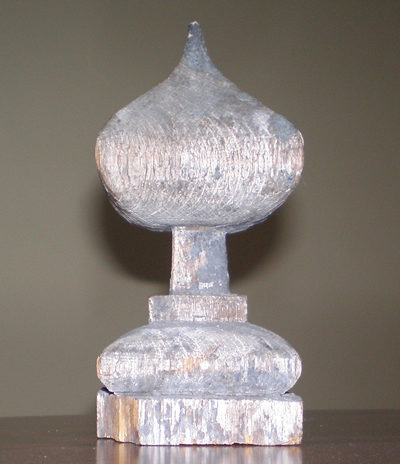 |
Photo of Finial recovered from Broughton Hall |
Miss Howard's Avis Motor Car
|
|
Pictured left is a small gallery of photographs showing the Alvis Drop Head Coupe used by Elizabeth Howard and referred to by Bill Freeman in his memories of Broughton Hall above. The Alvis (No 14062) was first registered to Elizabeth Howard in 1932. The photographs have been kindly provided by the current owner Mike Baker. |
|---|
Broughton Hall's Water Supply
Broughton Hall had it's own water supply which was pumped some 1250m from a pump house built at Queens Ford Bridge which spans the River Elk or Worthenbury Brook (AKA Sarn Brook). The photos in the gallery right show what is left of the building today with a well in front of it. The water from the river only provided power for the pump which in turn pumped fresh spring water to the house. In turn electricity powered the pump and finally mains water arrived some time in the 1950's. Water was carried in a large diameter lead pipe, remains of which can be seen in recently excavated tunnels adjacent to the site of the former house. You can click on each image to enlarge. |
|
|---|
Video of How Broughton Hall looked Prior to Demolition c 1961
The Final Sale of Broughton Hall
The Estate belonging to Broughton Hall was finally put up for sale in the summer of 1957 and the particulars below were put forward:-
1895 acres comprising of a) the Hall including 7 acres b) the Home Farm of buildings for a milking herd plus 138 acres in 4 lots c) 7 Woodlands of 41 acres d) 16 farms/small holdings e) 25 cottages.
Most of the farms and cottages were bought by sitting tenants however, one of the farms was sold on the open market and at the time in 1957 made £16,000. This has been resold in the last couple of years for £2,800,000 which makes one wonder what the whole estate could have been worth today.
A copy of the Swetenham Whitehouse auction sale particular detailing the antique and other residential contents of Broughton Hall can be viewed by clicking on the relevant (buff) front page below.
A copy of the Henry Manley & Sons auction sale catalogue detailing the agricultural assets to be sold can also be viewed by clicking on the relevant (blue) front page below.
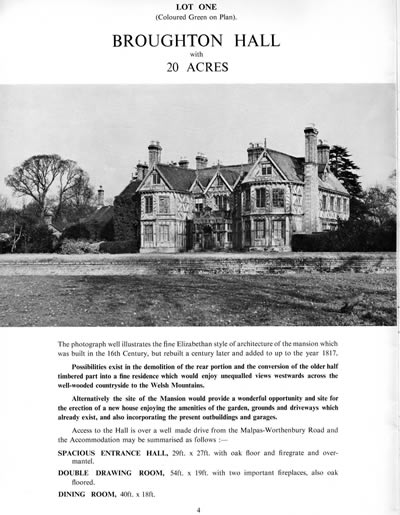 |
|
|
|---|---|---|
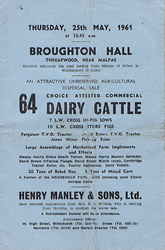 |
The Hall and the Home Farm were not sold in 1957 but were put forward for sale again in May of 1961 and this time the sale particulars included a) The Hall with 9 acres plus 11 acres of woodland which had all been felled and was for sale with replanting conditions attached b) Top Lodge with mains electricity, water and a septic tank c) Home Farm which still was set up for a milking unit still with 138 acres in 4 lots but this time included Middle Lodge which was promoted as having the potential of being occupied by an agricultural worker. In the particulars there was also reference to the Broughton Hall Estate Water Supply which as detailed above was drawn from a well by Queens Ford Bridge and the Caenant Wood 1250 metres away and would be subject to the cooperation of whoever bought one of the lots of land under which it passed in the lead pipe. However it was also detailed that mains water could be located opposite Top Lodge in the main road. |
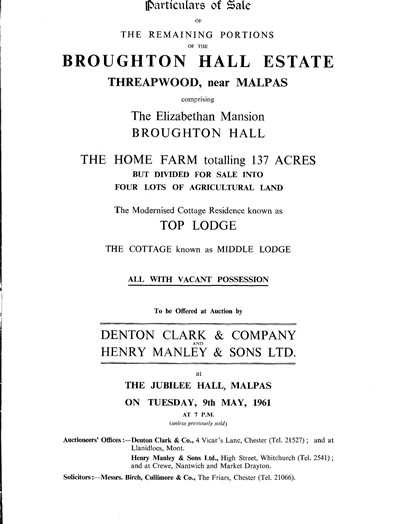 |
|---|
Correspondence
A visitor to the website has contributed these images of letters sent to Broughton Hall in the mid 1800's. The stamp of the day was the Penny Red which was introduced in 1841 and was in use until 1879. These letters were posted in 1856 and 1858 from Liverpool and Wrexham.
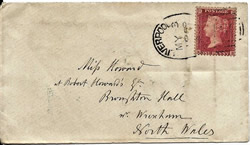 |
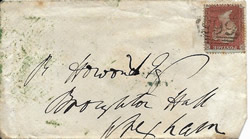 |
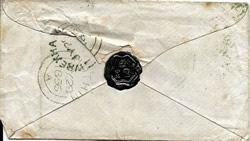 |

